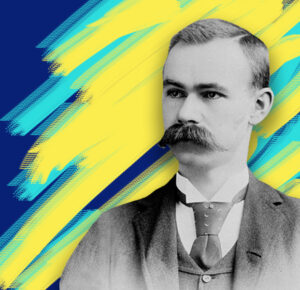Herman Hollerith – a name that many people may not be as familiar with as Bill Gates or Steve Jobs. However, Hollerith actually laid the foundation for the development and commercialization of data processing with his invention of an electromechanical evaluation machine at the end of the 19th century. His perforated card machine allowed large amounts of data to be evaluated quickly and precisely for the first time.
To commemorate his 164th birthday, we take a look at the history of this invention and its connection to today’s multinational technology giant IBM.
The origins of Herman Hollerith
Herman Hollerith was born on February 29, 1860, in Buffalo, New York. The son of German immigrants from the Palatinate showed an early interest in science and technology and eventually became an engineer. After completing his studies, he began his career at the US Census Bureau in 1879, where he first encountered the statistical challenges of the census.
When ones and zeros were still holes

At the census bureau, statistical surveys had previously been carried out manually and took several years. Hollerith was concerned with facilitating and accelerating statistical surveys by means of machine recording and evaluation. According to some accounts, Hollerith came up with the idea of perforated cards for data collection when he observed conductors punching hole patterns into tickets. He presented his electrical tabulating system, which transferred the information from questionnaires onto paper cards and then counted and sorted them according to various characteristics using electromagnetic counters and a sorting box. He received an award for his work at the Paris World Exhibition in 1889.
1890 census: data processing in record time
The crowning achievement of his success came in 1890, when Hollerith’s invention was used for the US census. The machine exceeded all expectations and accelerated the enumeration enormously: instead of taking eight years as in 1880, it only took one year to complete the census. Herman Hollerith’s invention revolutionized the efficiency of data collection.
The legacy of Herman Hollerith
Herman Hollerith’s tabulating technology paved the way for modern data processing and its commercialization. In 1896, he founded the “Tabulating Machine Company”, with which he marketed his invention worldwide. Hollerith later sold the company, which was renamed International Business Machines Corporation (IBM) after a merger (CTR) in 1924. The emergence of electronic data processing and more cost-effective alternatives eventually rendered the tabulating machine obsolete.
Did you know?
Further developments of Hollerith’s invention were used in US voting machines well into the 21st century. During the presidential election in Florida in 2000, however, the voting machines came under severe criticism due to inaccuracies in the vote count.
>> Other articles you might be interested in:
- 40 Years – 4 Perspectives: G&D through Four Different Lenses - 16. December 2025
- Trusted. Improved. VisionXS 2.0 - 15. October 2025
- bluedec™ – Our Video Compression for Control Rooms, Now Even More Powerful - 2. September 2025


Hi Eva,
also part of Holleriths legacy (sadly not mentioned in your article):
https://www.spiegel.de/wirtschaft/ibm-der-programmierte-massenmord-a-117132.html
Thank you for your comment, Dirk! We have focused on Hollerith’s life and his impact on data processing in this article. However, your comment highlights the importance of considering ethical issues surrounding technological advancement and the need for technology companies to take responsibility for ensuring that their products are not misused or manipulated for unsavory purposes.